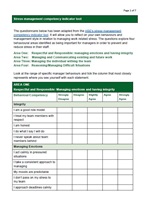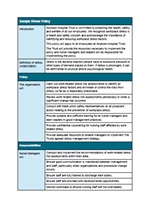Individuals who work in an environment considered to be supportive with clear goals and good team leadership, are less likely to have high stress levels. (West et al 2015). Compassionate leaders will increase staff engagement, produce better outcomes, and improve financial performance for their organisations.
Compassion can be defined as a ‘sensitivity to suffering in self and others with a commitment to alleviate and prevent it’ (Gilbert 2013) A compassionate leader understands the above definition, their focus is about looking after themselves and others, acknowledging that it is ok to be human, make mistakes and learn from them, and give themselves - and others, permission to do this.
Compassionate leaders focus on building relationships, supporting, and developing an open and non -blaming working environment, where innovation is encouraged.
To support employee’s wellbeing and reduce the risk of stress, as a leader your compassion should have a holistic approach that expands beyond the department’s walls. Work life balance is an essential element of reducing stress and as a leader it is important to ensure that your employees can access the resources to be healthy, productive, and financially stable. By promoting work-life balance, allowing a degree of flexibility, and showing empathy and understanding when a team member needs to take time out to care for a child, family member or themselves, will go a long way to support and improve your employees' well-being.
The by-product of compassionate leadership is a motivated and productive team that has a sharper focus on their goals, duties, and patient care.
The Royal College of Nursing (RCN) works on behalf of its members to promote the importance of a healthy work life balance regardless of gender, age and caring responsibilities and encourages all organisations to have effective policies in place for all staff, in order to promote balance between the demands of employment and responsibilities outside of work. (Put in link)
Where there is an absence of compassionate leadership, staff have reported feeling over worked, lack the ability to influence decision making processes, resulting in poorer outcomes for the organisation and for patients. The absence of compassionate leadership contributes to higher levels of stress amongst staff and lowers the rates of patient satisfaction. (West and Dawson 2012)
Many health care workers have stated they don’t have enough time for compassion as there is a need to focus on administration, regulation and cost cutting (Reiss et al 2012). While time pressures influence working environments within health, showing compassion to fellow team members and patients doesn’t take any longer. (Trzeciak 2019)
Leaders and team members can work together to create an environment where team members feel psychologically safe, share learning and review their work regularly to improve quality, which in turn increases productivity and transformation. There are practical tips for everyone, whatever your role or seniority to practice compassion. Link to the Four Pillars of compassionate Leadership
Low pay can also increase stress levels and the RCN will continue to fight for its members to receive the remuneration they deserve.







